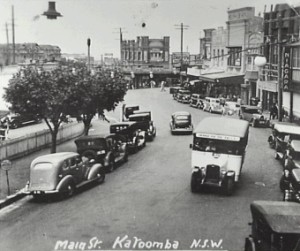The Story of Private John Parker
Veteran of The Great War
© John Low
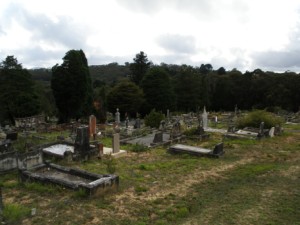
John Parker lies in an unmarked grave,1 one of many in the cemetery at Katoomba. Untended, it is indistinguishable from the unoccupied plots nearby. His death was one of those small tragedies reported occasionally in the local press and arousing for a brief moment a flutter of community interest before fading from memory. Parker’s tale may well bear retelling.
On the afternoon of Thursday 15th September 1932 a spring cart of unusual appearance, pulled by a bay horse, arrived in Katoomba. After calling at the police station to collect a food order the driver, a man in his ‘fifties, another of the wandering unemployed who passed regularly through the town, pulled up outside Bartle & Bell’s general grocery store in Main Street (Bathurst Road) where his conveyance drew a crowd of curious passers-by. At its four corners upright posts had been screwed, while a ridge pole rested on two further poles screwed down front and back. Over this frame the traveller had thrown his tent, creating a mobile home that kept out the weather and protected his few possessions.
He was, he told one of the constables, suffering from pernicious anemia and was heading west in the hope of finding a warmer, more comfortable climate. Completing his shopping, he left town and journeyed on for a mile or two before striking camp at the foot of Whipcord Hill just to the east of Medlow Bath.
On the following day, Friday, travellers on the road noticed his camp still there, his horse tied to a tree. He must have decided to rest a little longer they thought. When nothing had changed on Saturday, however, and no human activity was apparent, it was reported to the police. The local sergeant and his two constables motored out to investigate and found a hurricane lamp still burning in the cart and the body of a man in a sitting position, his head bent forward onto his chest. There were no signs of struggle and a local doctor (Dr. Eric Dark) summoned to the scene pronounced that death was due to natural causes. Among the man’s few possessions army discharge papers identified him as John Parker, a veteran of the Great War.2
John Parker, it seems, had always been a bit of a wanderer.3 He was born in Kent Town, a suburb of Adelaide, South Australia, in 1876 and when he came of age was apprenticed to a watchmaker in Adelaide. By the time he enlisted in the AIF, at the rather advanced age of 41, he was in NSW and gave his employment as “boundary rider”. He was 5 feet 8 3/4 inches tall, weighed 154 lbs, had blue eyes, dark hair (that was “turning grey” on his discharge three years later) and was of medium complexion. He had a wart near his navel and a tattoo on the under side of his upper left arm, was unmarried and a lady friend in Mudgee, Florence Sills, was recorded as his next of kin. She was the beneficiary of the will he wrote before departing Australia.
Parker enlisted in Sydney on the 29th March 1917 and embarked for Europe as a member of the 10th Reinforcement, 45th Battalion (part of the 12th Brigade, 4th Australian Division) aboard HMAT Marathon on the 10th May 1917. On arrival in England he was “marched into” the large training and transfer camp that had been established near the small Wiltshire village of Codford, not far from Stonehenge, to handle the thousands of Anzac troops preparing to move to France.
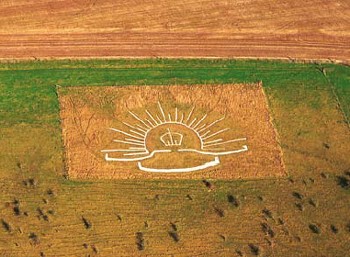
In 1917 soldiers at Codford left an unusual memento that has become a lasting reminder of their presence there. Using the glass bases of beer bottles they sculpted a large (53 x 45 metres) Rising Sun badge on the side of a nearby hill. Polishing the glass, the story goes, became a punishment duty and the slope, Lamb Down, became known as ‘Misery Hill’. The badge was covered with turf during World War II but its outline has since been restored by scouring it into the chalk of the hillside. Though the military camps have long gone, the villagers of Codford maintain their Australasian connection by holding a memorial service on Anzac Day every year.4
On 23rd October Parker proceeded across the Channel to France where he joined the 45th Battalion on 3rd November 1917. It is not known if he saw action immediately but, like most of the AIF battalions, the 45th was being rotated in and out of the front line during the 1917-18 winter months. Then came the German ‘Spring Offensive’! Freed from commitments on the Eastern Front following the Russian Revolution, the Germans poured huge numbers of troops into a major offensive against the Allied armies in the West during March, April and May 1918.
On 5th April the 45th Battalion, part of the 4th Australian Division, found itself caught up in the intense and chaotic fighting that took place along the River Ancre, a tributary of the Somme. It was here that Private Parker got sucked into the maelstrom. The morning that day dawned in rain and mist and the Germans, using the poor visibility and supported by heavy shell-fire, advanced against the Australian positions. The sustained bombardment took its toll and when the Germans broke through, desperate fighting continued well into the afternoon until an Australian counter-attack stabilized the situation. All along the line, against the British as well as the Australian positions, the Germans took heavy casualties, slowing their advance on Amiens.5
The Allies too suffered casualties and Parker was evacuated to the Fort Pitt Military Hospital at Chatham, Kent, on 7th April with chest wounds. Now a Girls’ Grammar School, Fort Pitt had been a military hospital since Victorian times and was where Florence Nightingale established the first Army medical school in 1860.6 He remained here for over a month before being sent again to Wiltshire on 24th May, to the Administrative Headquarters of No.4 Command Depot and Clearing (Convalescent) Hospital at Hurdcott. In a similar way to the Australians at Codford, those at Hurdcott also left a lasting reminder of their presence. In 1918 a giant map of Australia, cast in cement, was laid across a hillside that became known as ‘Australia Hill’.7
On 24th June Parker, now considered recovered from his wounds, was transferred to the Overseas Training Brigade at the nearby Sandhill Camp, Longbridge Deverill to prepare for a return to France. While here he forfeited four days pay for going AWL. Was this a last fling with a new lady friend? Parker had written a new will on 22nd June, leaving all his worldly possessions to Mary Sinclair of Kelty, Fife, Scotland. Was she a nurse who had looked after him perhaps?
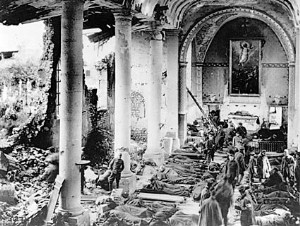
He proceeded to France once more on 12th September 1918 and joined the 4th Machine Gun Battalion for the remainder of the war. Kaiser Wilhelm II abdicated on 9th November and the Armistice was signed on 11th November. By 1st April 1919 Parker was back in England, granted six months leave to seek non military employment. Finding work in London as a watchmaker with the international jewellery firm, H. Williamson Ltd., he was offered a permanent position and in August applied to the AIF for a “Discharge in a Country other than Australia’ in lieu of repatriation home. He stated that: “Being in the watch and jewellery trade, I find there is an exceptional opportunity to better myself both in gaining knowledge in my line of business, also monitary (sic) for the next couple of years. … There is a scarcity of men on account of the Germans going out of the trade. I can benefit myself better here than in Australia for the next two years.” Anticipating his application’s approval, he took up the position with Williamson Ltd.
Then things got complicated. His application was refused and his leave cancelled on 8th September 1919. Failing to report on the required date, he became AWL from 20th September and on 9th December was declared an “illegal absentee”. This situation continued well into 1920 and Parker found he was facing charges of desertion. He was discharged officially on 21st July 1920 “in consequence of being illegally absent”.
Then, almost twelve months after being declared AWL, he finally reported to the AIF in September and argued his case: “I had applied for my discharge in UK”, he said, “and I was led to believe that I should have no difficulty in getting it. I had made certain business arrangements which I could not break from when my discharge was not approved. I was therefore forced to go AWL. I had no intention of deserting from the AIF.” His case was looked upon with a degree of favour for, while the discharge for illegal absence appears to have stood, his entitlement to appropriate war medals was restored.
While the facts of John Parker’s life during the next decade are unknown, it is clear that he did return to Australia as he intended. Whether his stay in England benefited him career-wise on his return we will never know, though the onset of the depression in the late 1920s clearly rendered any such advantage null and void. When he arrived in Katoomba he was both sick and unemployed. Nevertheless, you can sense in the interest and curiosity he aroused that, as in other aspects of his life, there was a defiant independence about the manner in which he made his way in an unkind world.
With Parker’s body in the local morgue, all efforts by the authorities in Katoomba to locate relatives failed. There were none to find. He had recorded no relatives at his enlistment and had informed the AIF Board of Inquiry in London that he had no relatives in Australia. His funeral was arranged by the Katoomba-Leura Branch of the R. S. & S. I. L. and he was buried in the Anglican section of Katoomba Cemetery on Tuesday, 20th September 1932 with representatives of the League in attendance and the Rector of St. Hilda’s Anglican Church officiating.
“I am pleased”, Rev. H. E. Taylor declared, “to see representatives of the Diggers here this morning to bear tribute to their departed comrade who was alone in the world. Occasions such as this”, he continued, “take us back into the past and we are helped to realize something of the havoc created by war. The price was paid in the blood of thousands of the best of our manhood, but the picture of suffering humanity – men still suffering from their experiences at the front – is almost heart-breaking.”8
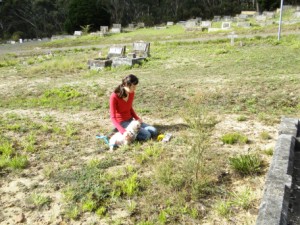
Three days later the physical evidence of Private Parker’s life – his horse, cart, harness, lamp and cooking utensils – was sold in the yard attached to Katoomba Courthouse.9 With this small final act of dispersal the community brought ‘closure’, to use a rather over-worked and 5modern expression, to this tragic episode and Parker slipped quietly from the business of the present.
The tale of John Parker is one of those fugitive stories that haunt the margins of history, hidden in the pages of old newspapers and files. Damaged by war and economic depression, forgotten by his country, he was a casualty of his time. When my daughter Marika and I located his grave last week it was overcast with the threat of rain and the sky over Mount Banks, just visible above the trees, was dark. We may well be the first people to visit him since 1932.
© John Low
notes
- Church of England Section 2, Row 1, Plot 26, Blue Mountains City Council Cemetery Register, accessed February 2009
- “A Hero’s Lonely Death”, Katoomba Daily, 20th September 1932
- On the AIF Nominal Roll there is only one John Parker whose age matches that of the digger found dead at Katoomba, a private with the regimental number 3695. A number of other factors, including his occupation at the time of enlistment and the fact that he was without relatives in Australia, add weight to the probability of this being a valid identification. His AIF Service Record, my source of information regarding his war experience, is available on-line at the National Archives of Australia’s web site, accessed February 2009
- Codford at Wikipedia, accessed March 2009; Also, ‘England’s Past For Everyone‘, accessed March 2009
- Commonwealth War Graves Commission (CWGC) web site, accessed March 2009
- Fort Pitt Grammar School web siteaccessed March 2009
- Australian War Memorial web site, accessed March 2009
- “Funeral of the Late John Parker”, Katoomba Daily, 22nd September 1932
- Katoomba Daily, 23rd September 1932

